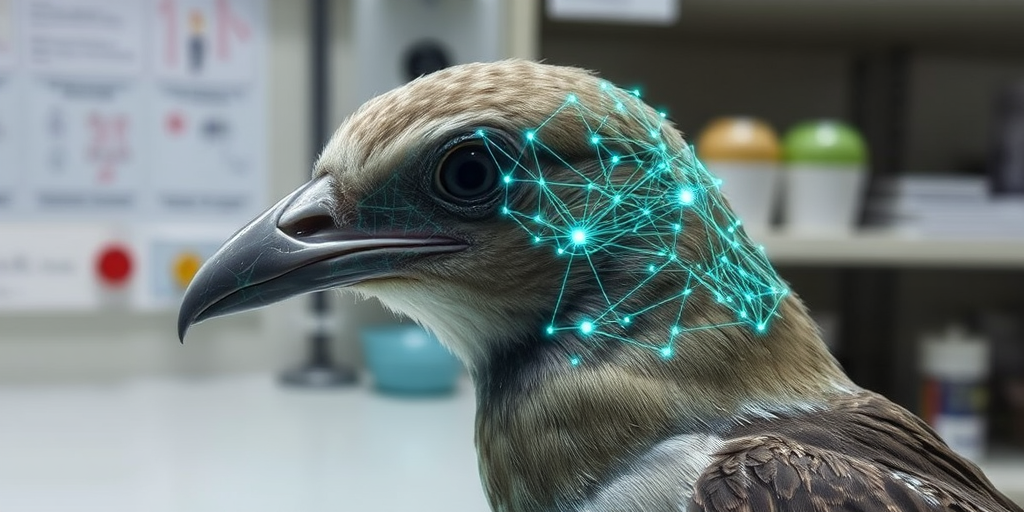Could the compact avian brain rival the cognitive powers of larger mammalian counterparts? Recent studies employing spatial transcriptomics and modern neuroimaging reveal that birds exhibit a unique neural circuitry characterized by high synaptic density and rapid neuron firing. These findings challenge conventional views on brain size and intelligence by demonstrating advanced problem-solving skills and intricate social behaviors across species. By examining detailed neural architectures and comparative anatomy, the article argues that the remarkable design of avian brains not only supports complex behaviors but also reshapes our understanding of cognition in the animal kingdom.
The Avian Brain: Cognitive Metrics and Complex Behaviors Across Species
Research reveals that problem‐solving behaviors in corvids defy the notion that small brain size limits cognition. Studies document corvids using complex tool strategies and adapting techniques to acquire food. Behavioral assays have quantified spatial mapping and decision‐making skills through controlled experiments that highlight these birds’ exceptional capacities.
Social learning mechanisms in songbirds further illustrate cognitive dynamism. Songbirds participate in intricate vocal learning, where individual variations in song structure are transmitted through observation and imitation. Researchers have employed controlled playbacks and social interaction trials to demonstrate that this learning enables rapid adaptation to environmental cues and social hierarchies.
Communication complexity in psittacines provides another measurable dimension of avian intelligence. Parrots have been observed engaging in structured exchanges featuring nuanced vocal signals and context‐dependent responses. These behaviors point to advanced neural processing that supports flexible interactions among flock members.
Tool utilization in resourceful flyers adds further evidence. Experimental setups have shown instances where certain species manipulate objects to extract otherwise inaccessible rewards. The ability to employ tools in problem resolution underscores refined cognitive processing that aligns with high-level planning and reasoning.
- Problem‐solving in corvids
- Vocal learning in songbirds
- Complex signaling in psittacines
- Tool use in resourceful flyers
Each bullet demonstrates a distinct aspect of cognitive performance that is consistently measurable through behavioral studies. Questions such as “What evidence supports advanced cognition in these birds?” can be answered by referring to the precision of outcome-based assays that document spatial mapping, tool use, and scripted vocal interactions. These quantified behaviors dismantle previous assumptions regarding limited avian intellect and instead map out a landscape of diverse, complex cognitive capacities across species.
Investigating The Avian Brain: Comparative Studies and Research Innovations

Modern imaging techniques have enabled detailed mapping of avian brain connectivity. Quantitative neuroethology employs behavioral assays in natural settings to measure cognitive performance. Experimental paradigms in feathered mind science combine field observations with controlled experiments, quantifying neural activation patterns and facilitating cross-species comparisons.
Integrative approaches reveal that sensory integration in parakeets refines neural processing, as documented in studies of rapid cognitive response.
Question: What quantifiable cognitive benefits does sensory integration offer parakeets?
Precision = Sensory integration enhances neural synchrony, leading to accelerated processing of environmental cues.
Integrated sensory inputs precisely align neural circuits for improved awareness and adaptive cognitive responses.
Modern imaging methods, including electrophysiological mapping, provide insight into neural connectivity. Quantitative assays sharpen understanding of brain function across diverse avian species through consistently rigorous, systematic cross-validation experiments.
- Brain connectivity mapping using modern imaging
- Quantitative neuroethology in wild aviators
- Experimental paradigms in feathered mind science
- Sensory integration insights from parakeet studies
These research innovations establish a framework for decoding neural dynamics in birds. Standardized assays merge structural and functional data, boosting our capacity to compare neural circuitry across species. The integration of neuroimaging with quantitative neuroethology refines insights into cognitive processes, yielding robust evidence of complex brain functions. Such cross-disciplinary efforts expand knowledge of avian cognition and inspire ongoing scientific inquiry, reflecting a shared passion for the intricacies of bird brain function. Continued advancements in experimental paradigms and imaging techniques promise to revolutionize the understanding of avian neural networks remarkably.
Final Words
In the action, the article outlined contemporary approaches to examine the intricate neural compositions and behavioral traits in birds.
Researchers have scrutinized the balance of excitatory and inhibitory neurons using modern imaging and experimental paradigms.
Evolutionary perspectives and comparative studies provided insights into brain connectivity and cognitive evolution across species.
The Avian Brain: Intelligence Across Species serves as a cornerstone for understanding advanced neural mechanisms.
Such findings foster expanding investigations and invigorate community enthusiasm in the domain of avian neuroscience.
FAQ
Q: Which bird species has the highest intelligence?
A: African Grey Parrots rank among the most intelligent birds, demonstrating advanced cognitive abilities including complex problem-solving, language comprehension, and mathematical skills comparable to young children.
Q: How does bird brain intelligence compare to other animals?
A: Birds exhibit intelligence levels comparable to primates, despite smaller brain sizes. Corvids (ravens, crows) and parrots display cognitive abilities matching great apes in problem-solving and tool use.
Q: What is the relationship between bird brain size and intelligence?
A: Brain-to-body ratio matters more than absolute brain size. Birds possess densely packed neurons in their forebrains, allowing advanced cognitive functions despite smaller overall brain volume.
Q: What makes owls intelligent birds?
A: Owls demonstrate specialized intelligence through excellent spatial memory, precise hunting strategies, and advanced sensory processing, rather than general problem-solving abilities like corvids or parrots.
Q: Which birds excel at problem-solving?
A: Corvids (crows, ravens, and magpies) excel at complex problem-solving tasks, including tool creation, multi-step puzzles, and social manipulation, demonstrating high cognitive flexibility.
Q: How do birds learn and communicate?
A: Birds learn through observation, imitation, and trial-and-error. Many species use sophisticated vocal communication systems, with some capable of learning and reproducing hundreds of distinct sounds.
Q: What are the key features of avian brain structure?
A: Avian brains contain densely packed neurons in the pallium region, specialized for rapid information processing, complex decision-making, and advanced cognitive functions.


